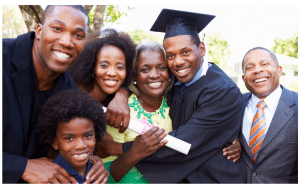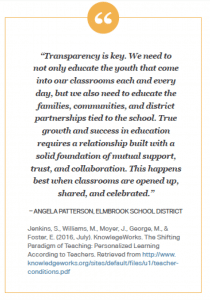How Can Families and Communities Support Personalized Learning?
Education Domain Blog
 This is the fourth blog in a series on What’s Possible with Personalized Learning? Read the first post, second post, third post, or download the entire report.
This is the fourth blog in a series on What’s Possible with Personalized Learning? Read the first post, second post, third post, or download the entire report.
Families, communities, teachers, parents and students around the country are coming together to explore how schools can better prepare students for postsecondary success. They are examining the promise of personalized learning as a means to better educate all students and prepare them to contribute to a more equitable, free, just and open society. Education leaders can help families and communities understand the promise of personalized learning by sharing student stories and teacher perspectives, found in our recent report.
Families are excited about personalized learning because:
- The unique needs of their children are being met.
- Families and teachers have a shared understanding of the learning goals for students and can work together to determine how they will get there.
- Personalized learning provides new educational resources, new learning opportunities and new ways to use knowledge while students engage with the world around them.
- Families will have better information and more details about what and how their children are learning instead of waiting for end-of-quarter letter grades. This allows families to be more involved in supporting their children and helping them at home.
- Students can work at a pace that is right for them, and school work is tailored to their interests and needs.
- Families have the opportunity to really help teachers to understand what they know about their own children and their strengths, weaknesses, goals and passions.
- Families have more opportunities to form relationships with the teachers and leaders in the school.
 There are many ways that families and communities can support personalized learning, whether their school or district is just getting started with exploring the “big questions” (at the start of this report) or whether they are many years into implementing these new practices. One of the best ways to support personalized learning is to consider your own beliefs and behaviors. Just as personalized learning will require some changes for students and teachers, it will also require some new ways for families to think about how schooling works.
There are many ways that families and communities can support personalized learning, whether their school or district is just getting started with exploring the “big questions” (at the start of this report) or whether they are many years into implementing these new practices. One of the best ways to support personalized learning is to consider your own beliefs and behaviors. Just as personalized learning will require some changes for students and teachers, it will also require some new ways for families to think about how schooling works.
In personalized learning, families change the way they talk about learning with their kids. For example, instead of emphasizing getting “All A’s,” parents engage their children in conversations about what they are curious about, how they like to learn best, what their interests are, how they have learned from a recent failure, and so on. In other words, the emphasis is on the process of learning and not just the end grade.
Families and community members can take advantage of opportunities to inform changes in the school by attending parent information nights, filling out online surveys, sending emails, mentioning concerns to teachers or leaders and sharing their ideas. Ideally, families and communities will have opportunities to be involved in the early phases of the shift to personalized learning and as new ways to teach and learn are put into practice.
Engaging the Community in Key Conversations
Schools transitioning to new learning models can engage family and community members to generate important conversations about what students in their community should know and be able to do as high school graduates. Community conversations build the mutual respect that is needed to create a culture of learning between communities, families and schools with broader needs in mind. It is important to have real conversations around the broader goals of education for our youth. In most districts, there are people and communities that either have had bad experiences in school or have historically been underserved and disrespected by school systems. Building trust takes time and requires the development of shared goals.
Districts must create a safe space for people to talk about what they want for their children, have honest conversations about the past, focus vision on future goals, discuss the current academic achievement levels and graduation rates, and share their fears as well as their hopes.
Pittsfield School District in New Hampshire is a great example of a school district that engaged their community and continues to host important conversations often. They learned that it was better to start by asking the community to share their insights and perspectives, rather than holding a meeting and telling the community what the school administration has already decided to do. Parents and families should think about how they would answer questions like, “What do you want for your children upon graduation?” They should also take advantage of opportunities to form and join school-community groups like Pittsfield’s Community Advisory Council.
The Council (renamed the “Good to Great Team”) continues to meet once a month as a full group and once a month in sub-teams that include talent management, community engagement, parent engagement and student engagement. Tobi Chassie, one of the people helping to personalize learning at Pittsfield explains, “Community engagement is the key to sustainability. If the district and school leaders fell off the face of the earth, the community would keep it going. They are creating the public demand.”
It’s time to re-engage the community in goals and aspirations for the future of education and have ongoing conversations to help keep progress moving forward.
For more on personalized learning, check out the following books:
- Building Powerful Learning Environments: From Schools to Communities by Arina Bokas
- How to Personalize Learning: A Practical Guide to Getting Started and Going Deeper by Barbara Bray and Kathleen McClaskey
- The Innovator’s Mindset: Empower Learning, Unleash Talent, and Lead a Culture of Creativity by George Couros
- Blended: Using Disruptive Innovation to Improve Schools by Michael B. Horn and Heather Staker
- One World Schoolhouse: Education Reimagined by Salman Khan
- Smart Parents: Parenting for Powerful Learning by Bonnie Lathram, Carri Schneider, Tom Vander Ark
- Beyond Reform: Systemic Shifts Toward Personalized Learning by Leslie Pynor, Katie Strom, Eric Haas, and Robert J. Marzano.
- Tapping the Power of Personalized Learning by James Rickabaugh
- The End of Average: How We Succeed in a World That Values Sameness by Todd Rose
Blog Series:
- New Report for Parents and Communities Opens Ideas on What is Possible with Personalized Learning
- What Does Personalized Learning Look Like in Schools?
- What Does Personalized Learning Mean for Students?
- What Does Personalized Learning Mean for Teachers?
Links:
- What’s Possible with Personalized Learning? An Overview of Personalized Learning for Schools, Families and Communities
- “Is Your Child’s School Student-Centered?” Checklist
- Blog: Engaging the Community
- Book: One World Schoolhouse: Education Reimagined
- Book: Smart Parents: Parenting for Powerful Learning